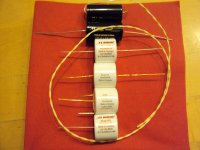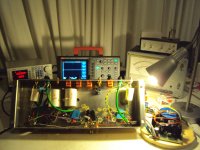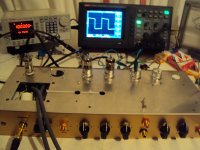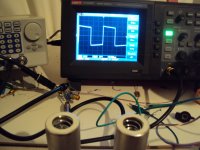Mostly i play prototypes without case. I connect the tonearm ground wire to a star earth usually and from there i do a wire to the turntable chassis so in my system everything is connected to main earth. I may have an unusual quiet earth though because my listening room is on the ground very near a long copper pole that is buried into the ground.
My main power for my system has a separate wire and silver fuses and special hall effect circuit breakers that are not in the signal chain.
My main power for my system has a separate wire and silver fuses and special hall effect circuit breakers that are not in the signal chain.
But do you reference your riaa amp circuit to that mains earth ? Or do you leave it floating without any connection to the tonearm gnd wire ?
Today i visited Mundorf. They gave me some new toys, silver-gold wire and the new cute EVO caps. We had a discussion about teflon caps and so far they are not happy with the tightness of the winding. Also copper foil sounded worse then metallized aluminum. They think because mechanical stability is more important. Pick your poison.
Thanks Raimund and Mirco.
Thanks Raimund and Mirco.
And that riaa ground ( circuit ground) is also connected to mains earth ?
P: Like your new toys... a lot 🙂
P: Like your new toys... a lot 🙂
Yes. It works in my system but it is important where the star ground is.
With stereo it is simple, i use batteries mostly anyway so i do the star between the batteries. Double mono is more complex. Honest i play around until the hum is gone.
Even a small hum can totally destroy the bass performance. Dead quiet is mandatory.
With stereo it is simple, i use batteries mostly anyway so i do the star between the batteries. Double mono is more complex. Honest i play around until the hum is gone.
Even a small hum can totally destroy the bass performance. Dead quiet is mandatory.
So at least for youToday i visited Mundorf. They gave me some new toys, silver-gold wire and the new cute EVO caps.
Thanks Raimund and Mirco.
 is early this year. 😀
is early this year. 😀I do not know why but i get a lot of samples from a lot of companies. Maybe they think i have good ears ?
I do not know why but i get a lot of samples from a lot of companies. Maybe they think i have good ears ?
Or
 they hope you do not 🙂 🙄
they hope you do not 🙂 🙄Sure, i do not care. But testing a lot i do and i give back reports. I am consistently bad C:

Many posts have been deleted at FdW's request (as they contain what could be misleading info) although this action should be seen as a one off.
Many posts have been deleted at FdW's request (as they contain what could be misleading info) although this action should be seen as a one off.
Thanks Mooly 🙂
Today i got one channel of my transimpedance tube RIAA for ETF 2012 working.
This did not come easy. Design and build took me the better part of one year, on and off.
I have great help from a very experience friend but i ran into several problems that drove me crazy. First i had a problem with the current sources and then i got oscillation. That proved to be a grounding issue of the heater supply and chassis.
Anyway, it works. With near textbook values i get a response that is flat from 100Hz to 100kHz ( -3dB ), under 100Hz i have some loss in the bass. That can be tuned in, tomorrow. I use a self conducting cascode with cascoded depletion mosfets at the input and a mü follower at the output so i have tremendous gain, around x266 in the input and
33 in the output for a total of 8800. That amplifies 0,5mV P-P to 4,4V P-P. I use very high transconductance russian tubes at the input and an E188CC at the output. Output impedance is 140 Ohm and there is a volume control in the RIAA. Noise will be low enough for medium to high output MC. For low output MC i build a box with transformers. At the moment i have no desire to share the circuit diagram. I have simply too much to do plus the crazy Paradise project. I hope i can get it working before ETF on both channels.
This did not come easy. Design and build took me the better part of one year, on and off.
I have great help from a very experience friend but i ran into several problems that drove me crazy. First i had a problem with the current sources and then i got oscillation. That proved to be a grounding issue of the heater supply and chassis.
Anyway, it works. With near textbook values i get a response that is flat from 100Hz to 100kHz ( -3dB ), under 100Hz i have some loss in the bass. That can be tuned in, tomorrow. I use a self conducting cascode with cascoded depletion mosfets at the input and a mü follower at the output so i have tremendous gain, around x266 in the input and
33 in the output for a total of 8800. That amplifies 0,5mV P-P to 4,4V P-P. I use very high transconductance russian tubes at the input and an E188CC at the output. Output impedance is 140 Ohm and there is a volume control in the RIAA. Noise will be low enough for medium to high output MC. For low output MC i build a box with transformers. At the moment i have no desire to share the circuit diagram. I have simply too much to do plus the crazy Paradise project. I hope i can get it working before ETF on both channels.
Attachments
Last edited:
Lookin' good Joachim !
You must get to bed earlier though.
( that's what I'm told anyhow )
Best time to work; the wee hours...
...just switched off the iron.
Good luck with channel 'B'.
Cheers
Si.
You must get to bed earlier though.
( that's what I'm told anyhow )
Best time to work; the wee hours...
...just switched off the iron.
Good luck with channel 'B'.
Cheers
Si.
I got the tube RIAA tuned. It spans 4 octaves from 20Hz to 200kHz ( -3dB ). I kept a small rolloff in the bass. I do not think it is a good idea to extent the deep bass response too much in a tube RIAA. High frequency extension is somewhat dependent on the volume control in the RIAA. Under worse case conditions ( potmeter in the middle position ) i still get 70kHz ( -3dB ). I put the amplification down by 6dB so it has now a maximum gain of x 4400. 1mV input give 4,4V output. The 1kHz square looks good with anti RIAA.
Photo later.
Photo later.



